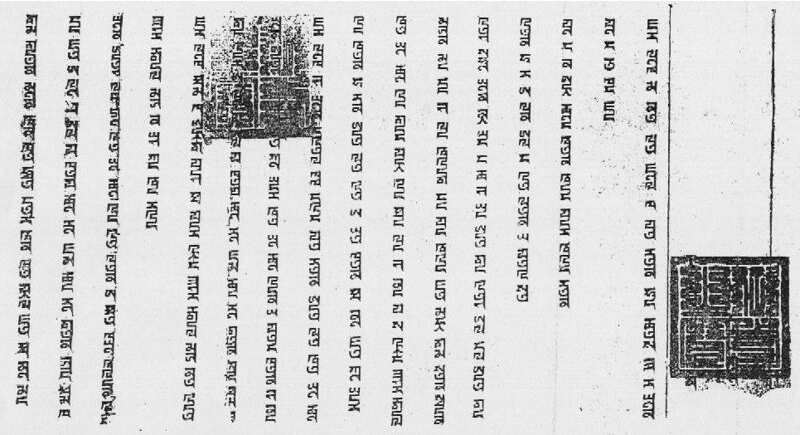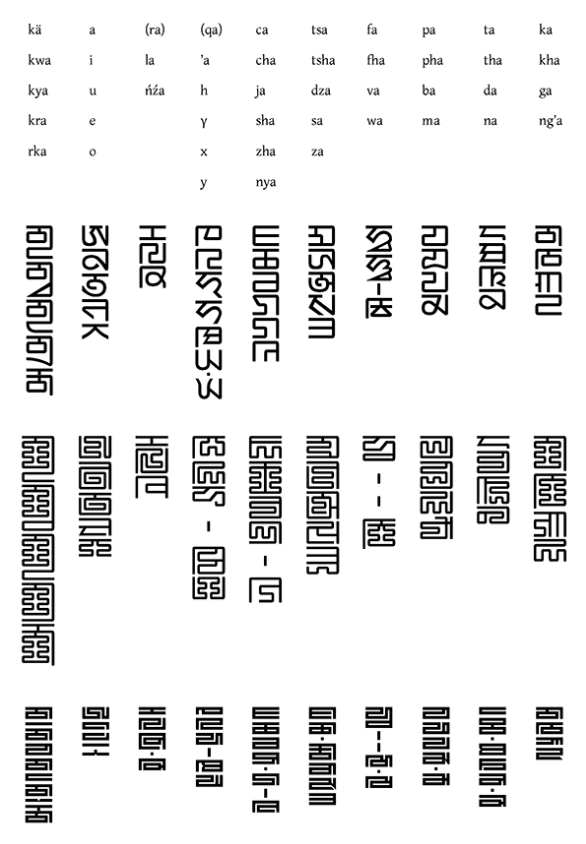
| Version | Summary | Created by | Modification | Content Size | Created at | Operation |
|---|---|---|---|---|---|---|
| 1 | Sirius Huang | -- | 953 | 2022-11-09 01:34:26 |
Video Upload Options
The ‘Phags-pa script (Mongolian: дөрвөлжин үсэг "Square script") is an alphabet designed by the Tibetan monk and State Preceptor (later Imperial Preceptor) Drogön Chögyal Phagpa for Kublai Khan, the founder of the Yuan dynasty, as a unified script for the written languages within the Yuan. The actual use of this script was limited to about a hundred years during the Mongol Yuan dynasty, and it fell out of use with the advent of the Ming dynasty. The documentation of its use provides clues about the changes in the varieties of Chinese, the Tibetic languages, Mongolian and other neighboring languages during the Yuan era.
1. History
The Uyghur-based Mongolian alphabet is not a perfect fit for the Middle Mongol language, and it would be impractical to extend it to a language with a very different phonology like Chinese. Therefore, during the Yuan dynasty (circa 1269), Kublai Khan asked 'Phags-pa to design a new alphabet for use by the whole empire. 'Phags-pa extended his native Tibetan alphabet, one of the Brahmic scripts, to encompass Mongol and Chinese, evidently Central Plains Mandarin.[1] The resulting 38 letters have been known by several descriptive names, such as "square script" based on their shape, but today are primarily known as the 'Phags-pa alphabet.
Despite its origin, the script was written vertically (top to bottom) like the previous Mongolian scripts. It did not receive wide acceptance, and was not a popular script even among the elite Mongols themselves, although it was used as an official script of the Yuan dynasty until the early 1350s[2] when the Red Turban Rebellion started. After this it was mainly used as a phonetic gloss for Mongolians learning Chinese characters. It was also used as one of the scripts on Tibetan currency in the twentieth century, as script for Tibetan seal inscriptions from the Middle Ages up to the 20th century and for inscriptions on the entrance doors of Tibetan monasteries.
2. Forms


Unlike the ancestral Tibetan script, all 'Phags-pa letters are written in temporal order (that is, /CV/ is written in the order C–V for all vowels) and in-line (that is, the vowels are not diacritics). However, vowel letters retain distinct initial forms, and short /a/ is not written except initially, making 'Phags-pa transitional between an abugida and a full alphabet. The letters of a 'Phags-pa syllable are linked together so that they form syllabic blocks.
'Phags-pa was written in a variety of graphic forms. The standard form (top, at right) was blocky, but a "Tibetan" form (bottom) was even more so, consisting almost entirely of straight orthogonal lines and right angles. A "seal script" form (Chinese 蒙古篆字 měnggǔ zhuànzì "Mongolian Seal Script"), used for imperial seals and the like, was more elaborate, with squared sinusoidal lines and spirals.
Korean records state that hangul was based on an "Old Seal Script" (古篆字), which Gary Ledyard believes to be 'Phags-pa and a reference to its Chinese name "蒙古篆字" (měnggǔ zhuànzì). (See origin of hangul.) However, it is the simpler standard form of 'Phags-pa that is the closer graphic match to hangul.
3. Letters
Following are the initials of the 'Phags-pa script as presented in the Menggu Ziyun. They are ordered according to the Chinese philological tradition of the 36 initials.
| No. | Name | Phonetic value |
'Phags-pa letter |
'Phags-pa Initial |
Notes |
|---|---|---|---|---|---|
| 1 | 見 jiàn | *[k] | Template:Phagspa | g- | |
| 2 | 溪 qī | *[kʰ] | Template:Phagspa | kh- | |
| 3 | 群 qún | *[ɡ] | Template:Phagspa | k- | |
| 4 | 疑 yí | *[ŋ] | Template:Phagspa | ng- | |
| 5 | 端 duān | *[t] | Template:Phagspa | d- | |
| 6 | 透 tòu | *[tʰ] | Template:Phagspa | th- | |
| 7 | 定 dìng | *[d] | Template:Phagspa | t- | |
| 8 | 泥 ní | *[n] | Template:Phagspa | n- | |
| 9 | 知 zhī | *[ʈ] | Template:Phagspa | j- | |
| 10 | 徹 chè | *[ʈʰ] | Template:Phagspa | ch- | |
| 11 | 澄 chéng | *[ɖ] | Template:Phagspa | c- | |
| 12 | 娘 niáng | *[ɳ] | Template:Phagspa | ny- | |
| 13 | 幫 bāng | *[p] | Template:Phagspa | b- | |
| 14 | 滂 pāng | *[pʰ] | Template:Phagspa | ph- | |
| 15 | 並 bìng | *[b] | Template:Phagspa | p- | |
| 16 | 明 míng | *[m] | Template:Phagspa | m- | |
| 17 | 非 fēi | *[p̪] | Template:Phagspa | f- | Normal form of the letter fa |
| 18 | 敷 fū | *[p̪ʰ] | Template:Phagspa | f¹- | Variant form of the letter fa |
| 19 | 奉 fèng | *[b̪] | Template:Phagspa | f- | Normal form of the letter fa |
| 20 | 微 wēi | *[ɱ] | Template:Phagspa | w- | Letter wa represents [v] |
| 21 | 精 jīng | *[ts] | Template:Phagspa | dz- | |
| 22 | 清 qīng | *[tsʰ] | Template:Phagspa | tsh- | |
| 23 | 從 cóng | *[dz] | Template:Phagspa | ts- | |
| 24 | 心 xīn | *[s] | Template:Phagspa | s- | |
| 25 | 邪 xié | *[z] | Template:Phagspa | z- | |
| 26 | 照 zhào | *[tɕ] | Template:Phagspa | j- | |
| 27 | 穿 chuān | *[tɕʰ] | Template:Phagspa | ch- | |
| 28 | 床 chuáng | *[dʑ] | Template:Phagspa | c- | |
| 29 | 審 shěn | *[ɕ] | Template:Phagspa | sh¹- | Variant form of the letter sha |
| 30 | 禪 chán | *[ʑ] | Template:Phagspa | sh- | Normal form of the letter sha |
| 31 | 曉 xiǎo | *[x] | Template:Phagspa | h- | Normal form of the letter ha |
| 32 | 匣 xiá | *[ɣ] | Template:Phagspa | x- | |
| Template:Phagspa | h¹- | Variant form of the letter ha | |||
| 33 | 影 yǐng | *[ʔ] | Template:Phagspa | ꞏ- | glottal stop |
| Template:Phagspa | y- | Normal form of the letter ya | |||
| 34 | 喻 yù | *[j] | Template:Phagspa | ʼ- | null initial |
| Template:Phagspa | y¹- | Variant form of the letter ya | |||
| 35 | 來 lái | *[l] | Template:Phagspa | l- | |
| 36 | 日 rì | *[ɲ] | Template:Phagspa | zh- |
4. Unicode
'Phags-pa script was added to the Unicode Standard in July 2006 with the release of version 5.0.
The Unicode block for 'Phags-pa is U+A840–U+A877:
U+A856 Template:Phagspa PHAGS-PA LETTER SMALL A is transliterated using U+A78F ꞏ LATIN LETTER SINOLOGICAL DOT from the Latin Extended-D Unicode block.[3]
References
- Coblin, W. South (2002). "Reflections on the Study of Post-Medieval Chinese Historical Phonology". in 何大安. 第三屆國際漢學會議論文集: 語言組. 南北是非 : 漢語方言的差異與變化. Taibei: Institute of Linguistics, Academia Sinica. pp. 23–50. ISBN 978-957-671-936-3. http://www.ling.sinica.edu.tw/files/publication/o0004_02_5568.pdf. Retrieved 21 October 2011. p. 31.
- Strange Names of God: The Missionary Translation of the Divine Name and the Chinese Responses to Matteo Ricci's "Shangti" in Late Ming China, 1583-1644, by Sangkeun Kim, p139
- West, Andrew (2009-04-04). "L2/09-031R: Proposal to encode a Middle Dot letter for Phags-pa transliteration". https://www.unicode.org/L2/L2009/09031r-n3567r.pdf.




